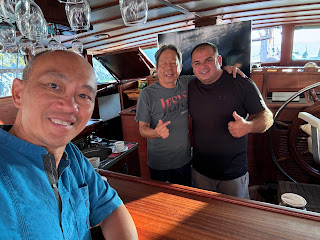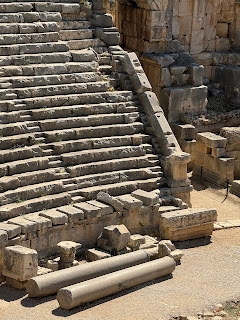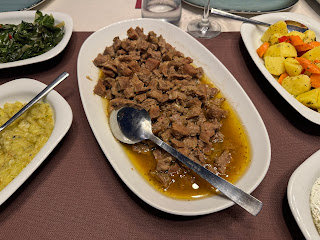The sun rose over Larin Su, casting a gentle light across the water as the day stirred awake. The air held a crisp freshness, tinged with the faint scent of salt, a reminder of the sea’s proximity. At 7:05 a.m., the deck was quiet, except for the rustle of the morning breeze and the soft murmur of waves against the hull.
David and I, still savoring the memory of the previous night’s feast, complimented Captain Emre on his lionfish catch. The sashimi, barely two hours from sea to plate, was as fresh as the sea itself—its taste a fleeting whisper of the ocean’s depth.
After a hearty breakfast, we boarded the dinghy bound for Demre, where our guide, Şerefe, awaited us with the bus. Our first destination was Myra, an ancient city steeped in history and the whispers of biblical tales. The city, etched into the stone cliffs, bore the remnants of a time when the living and the dead coexisted in the hollows of the earth. We wandered among the rock-cut tombs, their weathered facades telling stories of lives long past.
Ben, thoughtful and reflective, remarked on the biblical tale from Mark 5:1-9, where a man possessed by demons lived among the tombs. In his South African culture, such a life seemed unimaginable, yet here, in the shadow of these ancient graves, it was easier to conceive—a man sustained by the fruits of the land, hidden within these stone chambers. Perhaps, in the time of Jesus, similar tombs offered shelter to the forsaken.
As we explored, we noticed fragments of the past—a pomegranate carved in stone, the face of Medusa gazing from the ruins, and masks frozen in expressions that spoke of ancient dramas. Şerefe explained the origin of the word "hypocrite," rooted in the Greek tradition of masked actors, and it seemed fitting, here among the ruins of a theater.
The theater itself beckoned, its marble steps worn smooth by countless feet. We climbed to the top, cautious of the slippery stone, and there, among the carvings of Poseidon, we found a poppy flower. I wondered aloud if the ancients had known the secrets of the poppy, whether they had indulged in its opiate gifts. Historians might debate its use, but I imagined a cook, unwittingly intoxicated by the smoke of dried poppies tossed into a fire, sparking a ritual that would echo through the ages.
The heat pressed down upon us as we left the site, and just outside the gates, the group found respite in a glass of fresh orange juice, a small indulgence for a single euro. We rested briefly, then departed from Myra, our thoughts still lingering in the ancient city.
Next, we visited the Church of St. Nicholas, a short drive from Myra, where Şerefe shared the tale of its complex history. In 1856, the Russians, drawn by their deep reverence for St. Nicholas, purchased the site. But the Ottoman Sultan, wary of foreign powers holding sway over such a significant relic, quickly reacquired it. The details of the transaction have faded into obscurity, but the church remains a symbol of enduring Russian devotion. Though the saint’s relics were taken to Bari in 1087, the church still holds a powerful connection for Orthodox Christians, particularly those from Russia, who see it as the saint’s true resting place.
After visiting the church, and touching the feet of the bronze statue—a gesture signifying a return—I felt a sense of completion as we headed to Kas.
This small town, bustling yet quaint, offered us a couple of hours to explore. Some sought out a meal or a drink, while others meandered through shops that lined the streets, filled with trinkets and curiosities. Kas had changed, Ben noted, no longer the hidden gem it once was, now more polished and less intimate.
Back on Larin Su, the day closed with another lavish dinner. As the night deepened, a few of us gathered for a heated debate, the conversation turning to the conflicts in Ukraine and the ongoing tensions between Israel and Palestine. Voices rose and fell with the passion of our convictions, yet we all knew the limits of our discussion. Solutions were elusive, but the dialogue, like the day, was an exercise in understanding. We ended on a quiet note, and as I lay down, sleep came quickly, drawing the curtain on a day filled with the echoes of ancient Myra and the weight of modern concerns.



































No comments:
Post a Comment